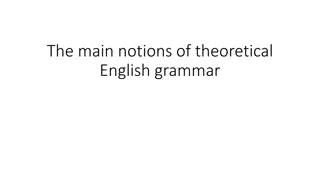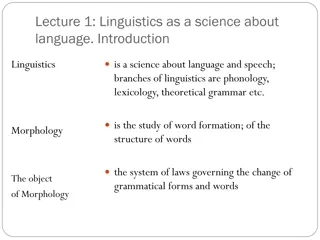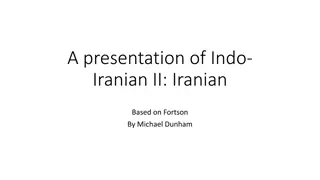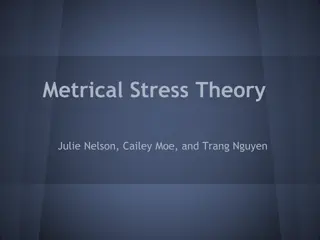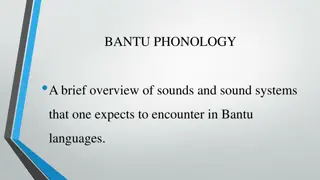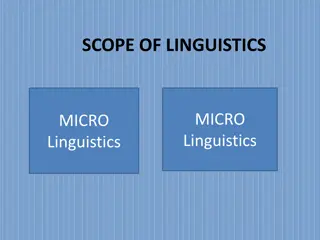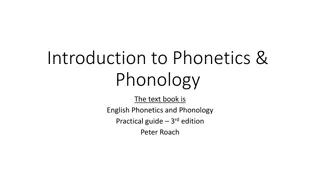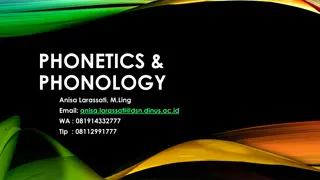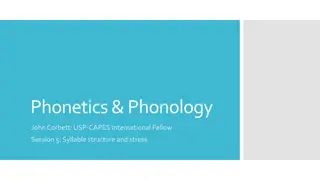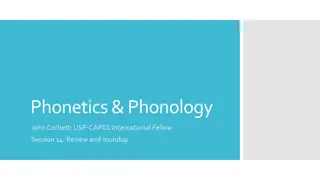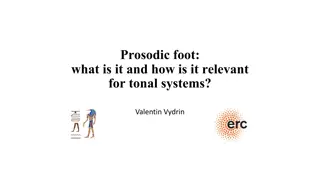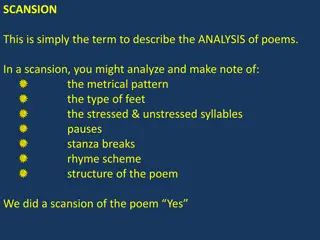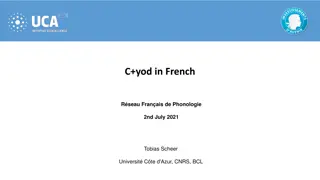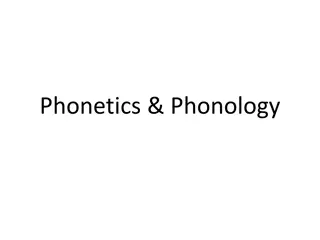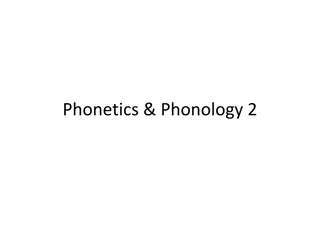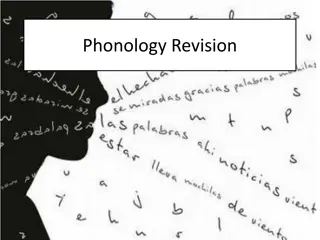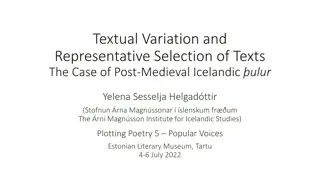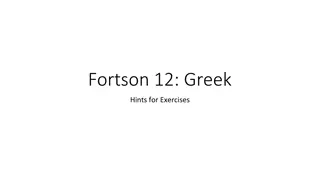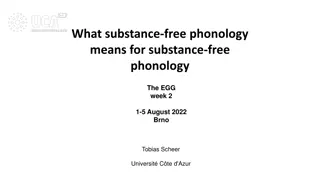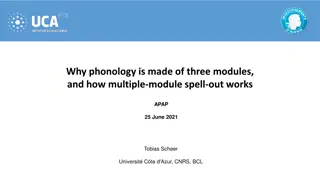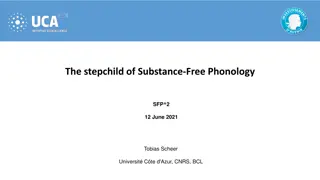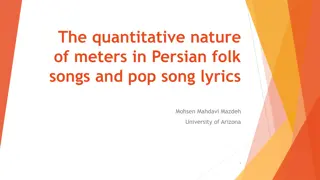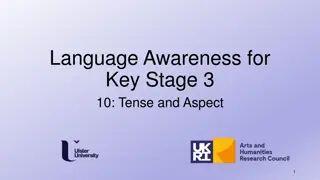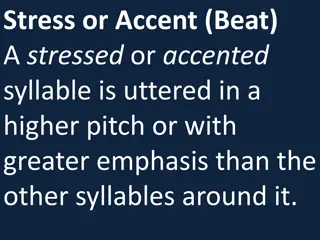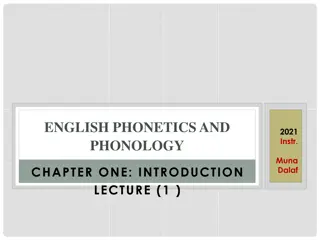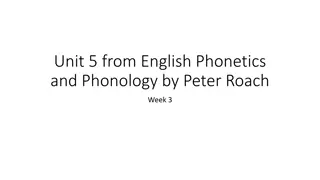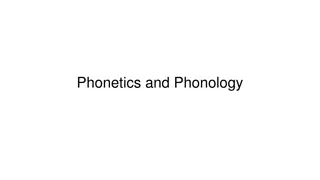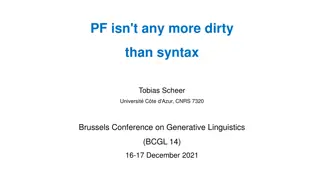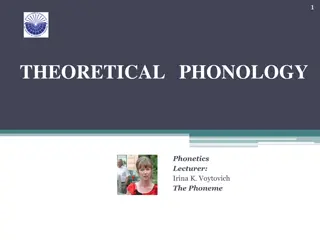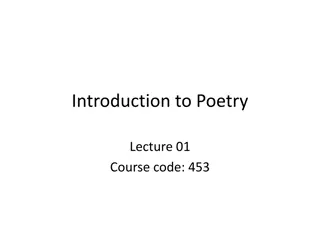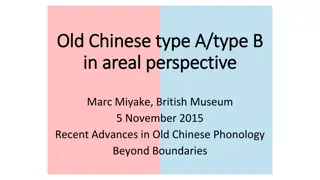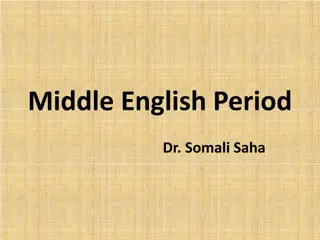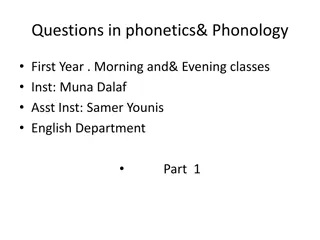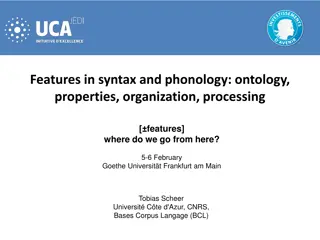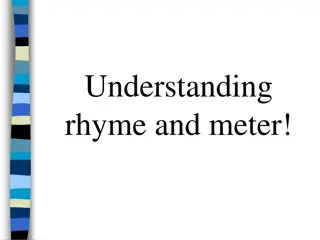Insights into Theoretical English Grammar
The theoretical English grammar delves into the subject matter of grammar, including systemic conceptions, grammatical forms, categories, paradigms, and morphological means. It discusses the constituent parts of language – phonology, lexicology, and grammar. The grammatical structure covers morpho
10 views • 26 slides
Is regressive voice assimilation a mirage?
Delve into the discussion on regressive voice assimilation, challenging traditional views of laryngeal phonology. Explore the intricate phonetic cues and contrasts that go beyond Voice Onset Time (VOT), examining the complexities of active [-voice] in voicing languages. Discover the prevalence of re
2 views • 28 slides
Linguistics: Exploring Language Structure and Morphology
Linguistics is the scientific study of language and speech, encompassing branches like phonology, lexicology, and morphology. This field delves into the levels of language structure, such as phonological, morphological, lexical, syntactic, semantical, pragmatical, and stylistical. Scholars began inv
8 views • 7 slides
Overview of Iranian Languages: A Linguistic Analysis Based on Fortson
Iranian languages, divided into Old, Middle, and Modern branches, exhibit distinct phonological and morphological features compared to Indic languages. The presentation explores differences in Iranian phonology, including deaspiration of voiced aspirates and spirantization of voiceless stops, and ex
1 views • 9 slides
Metrical Phonology: A Brief Overview
Metrical phonology, a subtheory of generative phonology, focuses on categorizing stress and stress rules within rhythmic hierarchies. It differs from generative phonology by not treating stress as a segmental feature specific to vowels. Originating from Halle's linear analysis, metrical stress theor
1 views • 32 slides
Bantu Phonology and Linguistic Classification
Delve into the intriguing world of Bantu phonology and linguistic classification, covering the diverse sounds and phonological processes found in Bantu languages. Discover the rich heritage of over 500 Bantu languages in sub-Saharan Africa, classified into zones and classes, shedding light on the fa
1 views • 38 slides
Overview of Micro and Macro Linguistics
Micro linguistics focuses on the scientific study of speech sounds, word formation, syntax, and meaning within a language, while macro linguistics delves into the societal, psychological, and neurological aspects of language use. Micro linguistic areas include phonetics, phonology, morphology, synta
2 views • 7 slides
Practical Guide to Enhance English Pronunciation Skills
Learning phonetics and phonology is crucial for foreign students of English to improve pronunciation. This guide provides practical tips, such as choosing an English accent, breaking down words into sounds, speaking slowly, and imitating English speakers to enhance pronunciation skills effectively.
0 views • 12 slides
Phonetics and Phonology in Linguistics
Phonetics and phonology are two essential fields in linguistics that focus on speech sounds in language. Phonetics involves the objective analysis of speech sounds, while phonology explores how these sounds form patterns in specific languages. Pronunciation problems often arise due to habit interfer
1 views • 56 slides
Syllable Structure and Stress in Phonetics and Phonology
Explore the concepts of syllable structure and stress in phonetics and phonology through examples like analyzing the number of syllables, phonemes, and stress patterns in words. Dive into syllable boundaries, onsets, nuclei, and rhymes in words and phrases to deepen your understanding of English pho
0 views • 35 slides
Phonetics and Phonology: A Focus on American English Sounds for Brazilian Learners
This session reviews key aspects of phonetics and phonology, specifically focusing on segmentals and suprasegmentals of English, with an emphasis on the pronunciation of American English sounds. The goal is to help Brazilian learners improve their pronunciation skills to sound more native-like. Topi
1 views • 18 slides
Prosodic Foot and Its Relevance in Linguistics
The prosodic foot is a vital unit in linguistic analysis associated with stress and word prominence. It serves as an intermediary between syllables and words, influencing tonal systems and phonological structures through patterns like metrical parsing and foot-headedness. Language-specific manifesta
11 views • 20 slides
Study of English Phonetic Courses at University of Ben Boulaid Moustafa
Explore the world of English phonetics at University of Ben Boulaid Moustafa, Batna-2, Algeria. Delve into articulatory phonetics, phonology, consonants, vowels, diphthongs, triphthongs, and more. Understand the branches of phonetics and the physical production of speech sounds.
0 views • 49 slides
Poetry Analysis: Scansion, Refrain, and Literary Devices
Delve into the world of poetry analysis with a focus on scansion, refrain, and literary devices such as apostrophe, abecedarian, metonymy, and synecdoche. Explore the nuances of metrical patterns, rhyme schemes, and organizational structures in poems, along with repeated refrains and figures of spee
0 views • 10 slides
French Phonology Study: C+yod in French Représentation
Research conducted by Tobias Scheer on 2nd July 2021 at Université Côte d'Azur, CNRS, BCL examines the occurrence of C+yod in French phonology. The study identifies specific patterns where C+yod occurs, emphasizing morphological boundaries and differentiating between lexical origins of the yod. Fu
0 views • 35 slides
Various Metrical Feet in Poetry
Delve into the world of metrical feet in poetry with examples ranging from iambic to trochaic, dactylic to amphibrachic. Learn about different rhythmic beats and meters, uncovering the essence of popular poems by Lord Byron, Shakespeare, Robert Browning, and Dr. Seuss. Discover how the choice of met
0 views • 16 slides
Exploring the World of Phonetics and Phonology
Delve into the fascinating realms of phonetics and phonology, where the science of human speech sounds is decoded. From the production to perception of sounds, this field encompasses articulatory phonetics, auditory phonetics, and acoustics phonetics. Discover how speech sounds are intricately forme
0 views • 25 slides
Phonetics and Phonology: Key Concepts and Differences
Phonology investigates sound distribution and interaction in language, providing an inventory of sounds and their interactions. Phonotactic constraints outline permissible sound sequences within a language, while phonemes and allophones distinguish between abstract and physical sound entities. Ident
0 views • 21 slides
Phonology Concepts in Language Learning
Phonology is the study of sounds in language and how they are produced. This content explores the production of sounds, types of sounds like plosives and fricatives, common phonological errors, and the "fis" phenomenon. It also discusses term deletion, exemplified by omission, substitution, addition
0 views • 13 slides
Textual Variation and Selection in Post-Medieval Icelandic ulur
This presentation discusses the challenges in structuring post-medieval Icelandic ulur, a genre of folk poetry, and proposes a possible solution using algorithms. It explores the variability and instability of ulur texts, highlighting the difficulty in defining them as poems. The speaker, Yelena Ses
0 views • 28 slides
Greek Phonology Exercises and Resources Overview
Explore Greek phonology exercises, resources like Wikipedia and Howe Library online, and key PIE sound transformations in Greek. Consult resources for laryngeal theory, Ancient Greek phonology, and Proto-Greek language.
0 views • 19 slides
Substance-Free Phonology and Its Implications
Substance-free phonology, as discussed by Tobias Scheer, explores the distinction between phonologically meaningful and meaningless items, highlighting their production and phonetic correlates. The article emphasizes the non-arbitrary nature of meaningful items and the arbitrary interchangeability o
0 views • 30 slides
The Three Modules of Phonology and Multiple-Module Spell-Out Systems
Phonology is structured into three modules - Sonority, Laryngeal, and Place - each with its own vocabulary and skeleton for computation. These modules interact in multiple-module spell-out systems to map linguistic structures onto phonetic realizations. Sonority, involving the audibility of linguist
0 views • 67 slides
Exploration of Substance-Free Phonology and Phonological Theory
This text delves into the concept of substance-free phonology, discussing the arbitrariness of phonological items, the distinction between phonologically meaningful and meaningless items, and the relationship between phonology and phonetics. It also explores the role of sonority in phonological theo
0 views • 11 slides
Quantitative Meters in Persian Folk Songs and Poetry
Delve into the quantitative nature of meters in Persian folk songs and pop song lyrics as discussed by Mohsen Mahdavi Mazdeh at the University of Arizona. The study explores how syllable weight, vowel length, and metrical patterns play vital roles in classical Persian poetry and the poetry of spoken
0 views • 19 slides
Tense and Aspect in Language Learning
Exploring the concepts of tense and aspect in language, this study delves into absolute, relative, and metrical tenses, illustrating how different languages express time relationships. It highlights the past, present, and future tenses, as well as relative tenses like past perfect, future perfect, a
1 views • 37 slides
Poetry Meter and Verse Types
Explore the various aspects of poetry meter and verse types including stress or accent, accentual verse, syllabic meter, and accentual-syllabic verse. Learn about stressed/accented syllables, rhythmical patterns, syllable counting, types of feet in poetry, and examples of different metrical structur
0 views • 18 slides
English Phonetics and Phonology: An Introduction
The study of English phonetics and phonology is essential for understanding the physical characteristics of human speech sounds and their distribution in language systems. Phonetics focuses on the sounds themselves, while phonology delves into their classification and patterns within a language. Key
0 views • 8 slides
Phonemes and Phonology in English
Exploring the concept of phonemes and phonology in English phonetics, this text discusses how sounds are produced, segmented, and categorized. It delves into the abstract string of sound units known as phonemes, different realizations of the same phoneme called allophones, and the use of symbols and
0 views • 7 slides
Invitation for Study of Enets Prosody: Phonology and Intonation Insights
Explore Enets phonology and intonation with Olesya Khanina from the Institute of Linguistics, Russian Academy of Sciences. Discover the unique set of phonemes, patterns of variation, and stress patterns at the word level. Uncover interesting questions about Enets prosody through digital corpora anal
0 views • 21 slides
Phonology: The Study of Speech Sounds in Language
Phonology is a branch of linguistics that focuses on the organization and usage of speech sounds in natural languages, with phonemes being the smallest units of sound that carry meaning. This field explores the sound structure of languages, highlighting the variety of phonemes present across differe
0 views • 19 slides
Minimalist Approach to Syntax and Phonology in Linguistics
The discussion delves into the relationship between syntax and phonology in linguistics, emphasizing the minimalist approach that aims to create a clean syntax while considering phonology as an ancillary element. It explores the idea that syntax is central to grammar, while phonology is considered '
0 views • 40 slides
Introduction to Theoretical Phonology: Understanding Phonemes and Speech Sounds
The lecture explores the fundamental concepts of phonology, focusing on phonemes, speech sounds, phonological theories, and their historical background. It delves into the functions of phonemes in forming language units, distinguishing words, and their connection to meaning. Various theories and fun
0 views • 43 slides
Emily Dickinson's Poetry: Themes, Literary Devices, and Metrical Analysis
Dive into the world of Emily Dickinson's poetry with an exploration of her themes, use of literary devices, and a detailed analysis of metrical patterns in her work. Discover the paradoxes, personifications, and unconventional techniques that make her poems unique, while unraveling the interconnecte
0 views • 23 slides
Poetry: Forms, Devices, and Rhythms
Poetry utilizes various forms, devices, and rhythms to evoke emotions and convey multiple layers of meaning. Poetic devices such as rhyme, rhythm, metaphor, and simile play a crucial role in creating musicality and depth in poems. Understanding the organization of speech rhythms, accent patterns, an
0 views • 45 slides
Recent Advances in Old Chinese Phonology: Areal Perspectives and Syllabic Types
Explore the evolution of Old Chinese phonology through an areal perspective, focusing on the classification of syllabic types into Type A and Type B with further interpretations by linguistic scholars like Karlgren, Pulleyblank, and Norman.
0 views • 49 slides
Influence of the Norman Conquest on Middle English Literature
The Norman Conquest greatly impacted Middle English literature, shaping its nature and character. This influence brought about contact with European literature, a shift away from heroic themes, incorporation of sunny nature aspects, use of rhymed verse forms, existence of various literary dialects,
0 views • 6 slides
Questions in phonetics& Phonology
In this material, students will engage with various exercises related to phonetics and phonology. They will identify articulators, phonemic symbols, and sounds in words. Additionally, they will practice recognizing specific sounds within word options provided. The content also includes exercises on
0 views • 9 slides
Parametric Information in Syntax and Phonology: Features, Organization, Processing
Role of parametric information in syntax and phonology, focusing on features such as tense, aspect, and vocabulary distinctions. Delve into how parametric information impacts computation and language acquisition, distinguishing between merge-created hierarchies and lattices.
0 views • 57 slides
Master Rhyme and Meter Basics!
Immerse yourself in the world of rhyme and meter in poetry, learn the symbols and patterns, understand feet in poetic structure, and practice identifying various metrical patterns. Explore the relationship between stressed and unstressed syllables to create rhythmic verses. Enhance your understandin
0 views • 11 slides
